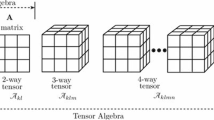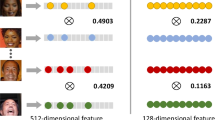Abstract
In recent years, the sparse representation modeling of signals has received a lot of attention due to its state-of-the-art performance in different computer vision tasks. One important factor to its success is the ability to promote representations that are well adapted to the data. This is achieved by the use of dictionary learning algorithms. The most well known of these algorithms is K-SVD. In this paper, we propose a stochastic framework for K-SVD called \(\alpha\)K-SVD. The \(\alpha\)K-SVD uses a parameter \(\alpha\) to control a compromise between exploring the space of dictionaries and improving a possible solution. The use of this heuristic search strategy was motivated by the fact that K-SVD uses a greedy search algorithm with fast convergence, possibly leading to local minimum. Our approach is evaluated on two public face recognition databases. The results show that our approach yields better results than K-SVD and LC-KSVD (a K-SVD adaptation to classification) when the sparsity level is low.











Similar content being viewed by others
References
Aharon M, Elad M, Bruckstein A (2005) K-SVD: Design of dictionaries for sparse representation. In: Proceedings of SPARS05, pp 9–12
Cai P, Wang G, Zhang H (2014) K-SVD with reference: an initialization method for dictionary learning. Neural computing and applications, pp 1–12. doi:10.1007/s00521-014-1607-z
Davenport MA, Wakin MB (2010) Analysis of orthogonal matching pursuit using the restricted isometry property. IEEE Trans Inf Theory 56(9):4395–4401
Elad M (2010) Sparse and redundant representations: from theory to applications in signal and image processing, 1st edn. Springer, Heidelberg
Elad M, Aharon M (2006) Image denoising via sparse and redundant representations over learned dictionaries. IEEE Trans Image Process 15(12):3736–3745. doi:10.1109/TIP.2006.881969
Georghiades A, Belhumeur P, Kriegman D (2001) From few to many: Illumination cone models for face recognition under variable lighting and pose. IEEE Trans Pattern Anal Mach Intell 23(6):643–660
Golts A, Elad M (2015) Linearized kernel dictionary learning. CoRR. arXiv:1509.05634
Huang K, Aviyente S (2006) Sparse representation for signal classification. In: Advances in Neural Information Processing Systems (NIPS 2006). MIT Press, pp 609–616
Jiang Z, Lin Z, Davis L (2011) Learning a discriminative dictionary for sparse coding via label consistent k-svd. In: 2011 IEEE Conference on Computer Vision and Pattern Recognition (CVPR), pp 1697–1704. doi:10.1109/CVPR.2011.5995354
Jiang Z, Lin Z, Davis LS (2013) Label consistent k-svd: Learning a discriminative dictionary for recognition. IEEE Trans Pattern Anal Mach Intell 35(11):2651–2664
Jin W, Wang L, Zeng X, Liu Z, Fu R (2014) Classification of clouds in satellite imagery using over-complete dictionary via sparse representation. Pattern Recognit Lett 49:193–200. doi:10.1016/j.patrec.2014.07.015
Kuang Y, Zhang L, Yi Z (2014) An adaptive rank-sparsity k-svd algorithm for image sequence denoising. Pattern Recognit Lett 45:46–54. doi:10.1016/j.patrec.2014.03.003
Mairal J, Bach F, Ponce J, Sapiro G, Zisserman A (2008) Discriminative learned dictionaries for local image analysis. In: CVPR
Martinez AM, Benavente R (1998) The AR Face Database. Tech. rep, CVC
Natarajan BK (1995) Sparse approximate solutions to linear systems. SIAM J Comput 24(2):227–234
Oja E, Hyvrinen A, Hoyer P (1999) Image feature extraction and denoising by sparse coding. Pattern Anal Appl 2(2):104–110. doi:10.1007/s100440050021
Pati YC, Rezaiifar R, Krishnaprasad P (1993) Orthogonal matching pursuit: Recursive function approximation with applications to wavelet decomposition. In: 1993 IEEE Conference Record of The Twenty-Seventh Asilomar Conference on Signals, Systems and Computers, pp 40–44
Ptucha R, Savakis A (2014) Lge-ksvd: Robust sparse representation classification. IEEE Trans Image Process 23(4):1737–1750. doi:10.1109/TIP.2014.2303648
Rubinstein R, Zibulevsky M, Elad M (2008) Efficient Implementation of the K-SVD Algorithm using Batch Orthogonal Matching Pursuit. Tech. rep
Wright J, Yang A, Ganesh A, Sastry S, Ma Y (2009) Robust face recognition via sparse representation. IEEE Trans Pattern Anal Mach Intell 31(2):210–227. doi:10.1109/TPAMI.2008.79
Zhang Q, Li B (2010) Discriminative K-SVD for dictionary learning in face recognition. In: 2010 IEEE Conference on Computer Vision and Pattern Recognition (CVPR), pp 2691–2698. doi:10.1109/CVPR.2010.5539989
Acknowledgments
The authors acknowledge the support of CNPq (Grant 456837/2014-0).
Author information
Authors and Affiliations
Corresponding author
Rights and permissions
About this article
Cite this article
Malkomes, G., de Brito, C.E.F. & Gomes, J.P.P. A stochastic framework for K-SVD with applications on face recognition. Pattern Anal Applic 20, 845–854 (2017). https://doi.org/10.1007/s10044-016-0541-3
Received:
Accepted:
Published:
Issue Date:
DOI: https://doi.org/10.1007/s10044-016-0541-3




